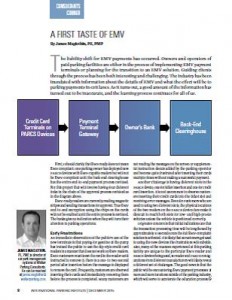The liability shift for EMV payments has occurred. Owners and operators of paid parking facilities are either in the process of implementing EMV payment terminals or planning for the transition to an EMV solution. Guiding clients through the process has been both interesting and challenging. The industry has been inundated with information about the details of EMV and what the effect will be to parking payments in exit lanes. As it turns out, a good amount of the information has turned out to be inaccurate, and the learning process continues for all of us.
First, I should clarify that EMV ready does not mean EMV compliant. One parking owner has deployed new PARCS devices with EMV-capable readers but will not be EMV-compliant until the back-end clearinghouse has the entire end-to-end payment process certified. For this project that will involve having four different links in the chain of the approval process certified as in the diagram above.
EMV-ready readers are currently reading magnetic stripes and sending transactions for approval. True EMV end-to-end encryption using the chips on the cards will not be enabled until the entire process is certified. The banks give no indication when they will turn their attention to parking operations.
Early Frustrations
An immediate observation of the public’s use of the new terminals is that paying for gasoline at the pump has trained the public to use the dip-style credit card readers in a manner that does not work on EMV readers. EMV customers must leave the card in the reader until instructed to remove it; there is a one- to two-second period after insertion before the message is displayed to remove the card. Frequently, customers are observed inserting their cards and immediately removing them before the process is completed. Many customers are not reading the messages on the screen or supplemental instruction decals added by the parking operator and become quite frustrated after inserting their cards multiple times without making a successful payment.
Another challenge is having different slots in the PARCS device, one for ticket insertion and one for credit card insertion. It is not uncommon to observe customers inserting their credit cards into the ticket slot and receiving error messages. Even for customers who are used to using two different slots, the physical locations of the two readers on the PARCS device face make it difficult to reach both slots for low- and high-profile vehicles unless the vehicle is positioned correctly.
Of greater concern is that initial indications are that the transaction processing time will be lengthened by approximately 10 seconds once the full EMV-complaint solution is activated. It is likely that as customers get used to using the new devices the frustrations will subside. Also, many of the nuances experienced at this parking facility are unique to the particular EMV reader and PARCS devices being used, so reader and PARCS configurations from different manufacturers will likely reveal a different set of challenges. The good news is that the public will be encountering EMV payment processes at more and more locations outside of the parking industry, which will serve to accelerate the education process.
James Maglothin, PE, PMP, is director of car park management systems at Walker Parking Consultants. He can be reached at james.maglothin@walkerparking.com.
TPP-2015-12-A First Taste of EMV

